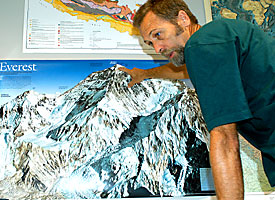 |
|
MICHAEL GIDALY/Arizona Daily Wildcat
|
Associate department head of geosciences George Gehrels discusses the recent discovery by UA scientists that the Himalayan mountain range is part of a 500 million-year-old mountain system.
|
|
|
By Ashley Nowe
Arizona Daily Wildcat
Tuesday October 7, 2003
UA scientists have discovered that the highest mountains on Earth actually sit atop another mountain range that is nearly 10 times older.
The Himalaya Mountains of Nepal, India and Bhutan, were originally thought to stand alone at the age of 55 million-years-old, created when India crashed into Asia, but new discoveries show that the mountain range is part of a 500 million-year-old mountain system.
The discovery leads scientists to believe that this newly discovered ancient mountain range came about when India collided with a still unknown landmass to the north.
"This really leads to the question of what the world looked like 500 million years ago," said George Gehrels, associate department head and professor of geosciences.
It is theorized that 450 to 500 million years ago, rocks in the Himalayas were pushed down below Earth's crust and were changed by the heat. The deeply imbedded rocks were brought back to the surface by processes such as erosion caused from weathering and the formation of fault lines, Gehrels said.
"What we are seeing is the roots of this earlier mountain formation," said UA geosciences professor Peter DeCelles. "The new mountain range is still being pushed up even today."
The ancient findings are significant not only because of their age, but also because it causes scientists to rethink the global climate change and the shift in seawater composition, Gehrels said.
The Himalaya Mountains shed enormous amounts of sediment that flow from the river systems into the oceans, which causes carbon dioxide loss in the atmosphere and in return cools Earth's climate.
Taking away carbon dioxide is like taking a blanket off of Earth," Gehrels said. "It causes the entire Earth to get a whole lot cooler."
Though it may not feel cool, the fact is that during most of Earth's history there were no polar ice caps, DeCelles said.
The eroded sediment that is swept away by systems like the Indus River and the Ganga River flows into the ocean, changing its composition.
"This definitely may have played a role into what is in the ocean," Gehrels said. "We might have found the answer for why earth's climate and sea composition changed drastically at this point in time."
The team of scientists began researching the Himalaya Mountains in 1996, becoming more intrigued after noticing fossils that suggested the mountain chain was older than believed.
The bewildered scientists pieced together the mystery of these aged rocks when results from samples began coming in last year, showing that the mountains were in fact a part of an older mountain chain.
Samples were gathered over the years and then tested by the UA's one-of-a-kind mass spectrometer, a machine that measures the decay of uranium into lead, allowing the age of the tested materials to be revealed.
In order to gather samples, the team of scientists had to walk for many days.
"It is a mind-boggling country site," DeCelles said. "When you are hiking for that long you just get into a zone and it's wonderful."
UA scientists would like to return to the site to gather more evidence to determine if the old mountain range is still largely present or isolated.
"There are still a lot of unanswered questions because we are looking at half a mountain range right now and we would love to find the other half," Geherls said. "There are two pieces of a jigsaw puzzle and our goal is to put this together."
